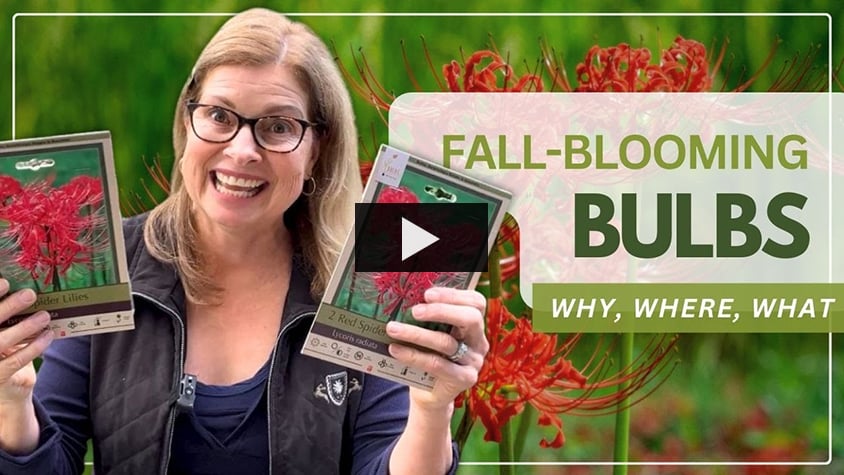7 Tips for Beautiful Bulb Garden Design
Create stunning garden displays with seasonal flower bulbsDesigning with bulbs can be an exciting way to create various "wow" moments in your garden. One common method of placing bulbs is to throw a handful into a garden bed and plant them where they land, which results in a natural-looking display of blooms. However, with a bit of creativity, there are many other ways to achieve fabulous results using bulbs.
1. CREATE COLOR ECHOES
Creating color echoes is a well-known design concept for flowering shrubs, perennials, and annuals. But, don’t forget to include bulbs! Some of the most impactful color echoes can result from a flowering bulb that echoes nearby foliage or flowers. Take it one step further and pull out unusual sources of color that might result from your flowering bulb, such as a secondary, less-obvious color from a petal, stem, or leaf.

The soft yellow and white daffodils echo the variegated foliage of the neighboring Iris pallida ‘Variegata’. Photo by: Rebecca Sweet.
2. TREAT AS EPHEMERALS
Ephemerals are wildflowers typically found in a woodland setting that briefly appear in early spring. They grow underneath deciduous trees, taking advantage of the sunlight before the tree’s canopy fills out and creates dense shade. Once the shade appears, the ephemerals fade away until the following spring. It’s a glorious thing to see these fleeting moments of beauty!
Even though bulbs aren’t technically considered ephemerals, by planting them beneath a large deciduous tree or shrub, the concept is similar—letting the bulbs take advantage of the temporary sunny location, fading away once the shrub or tree begins to leaf back out.

Taking advantage of the late winter sun, a carpet of crocus blooms under a deciduous tree. The flowers are finished once the tree begins to leaf out again. Photo by: Rebecca Sweet.
3. VARY BULB HEIGHT
When planting a traditional garden bed, a common strategy is to place taller plants in the back, medium plants in the middle, and smaller plants in the front. The same concept can be applied to bulbs by using varieties with varying heights.
This strategy allows for smaller bulbs to be better appreciated when planted up front, and create visual depth with taller blooms planted in the back of the border. The result is a much more engaging and dynamic garden, encouraging one to spend a little more time taking it all in before moving on.

Small white rain lilies bloom in front of the taller Begonia boliviensis. Photo by: Rebecca Sweet.
4. PLANT IN DRIFTS
Create some garden drama by planting a drift of bulbs versus evenly spacing them throughout the garden. For instance, a swath of 50+ blooming Muscari bulbs creates much more excitement than if they were sporadically planted here and there in small clusters.
Drifts also create visual movement, encouraging guests to follow the drift to explore the rest of the garden.

A mass of lavender grape hyacinths creates a visual impact, exciting to view both up close and farther away. Photo by: Rebecca Sweet.
5. USE CONTAINERS TO TEST COLORS
While there’s nothing wrong with enjoying a big container of brightly colored bulbs on your patio or near your front door, why not take advantage of the pot’s mobility and place it within your garden bed? This is a fantastic way to test a particular color combination without the commitment of planting the bulbs in the ground. If it’s not quite right, simply move the container to different areas in the garden until you find the perfect spot or the desired color combination from surrounding plants. When the bulbs are finished blooming you can plant them in the ground with confidence, knowing they’ll look fabulous next year.

A blooming pot of orange tulips nestled within the garden bed not only adds height, but allows for experimenting with colors. Photo by: Rebecca Sweet.
6. DISGUISE DYING FOLIAGE
As a bulb’s flower and foliage begin to fade, it’s tempting to tidy up and remove the dying leaves. However, fight that temptation! While perhaps a little unsightly looking, the foliage is busy gathering energy to store in the bulb for next year’s flower. Remove the foliage too early, and you’ll have much smaller (if any) blooms the following year.
One method to disguise unsightly foliage is to plant the bulb behind or near low-growing evergreen plants or ornamental grasses. By doing this, when the foliage begins to flop, it can neatly be tucked behind the plants in front, allowing them to fade away at their own pace.
Once the foliage is tan-colored and dried out, it’s safe to remove. At this point, the foliage should easily pull away from the bulb, but if not, use pruners to avoid accidentally dislodging the bulb.
Another similar method to disguise a bulb’s dying foliage is to plant the bulb near perennials or annuals that will begin growing just as the bulb is finished blooming. Similar to the evergreen plant strategy, the perennials or annuals will partially grow over the foliage, hiding it from view and letting it slowly fade away.

The gray foliage of the Senecio ‘Silver Gleam’ highlights the purple Allium ‘Lavender Bubbles’ and hides the fading foliage. Photo by: Rebecca Sweet.
7. STAGGER BLOOM TIME
Having a four-season garden, with something blooming throughout the entire year, is a goal for many gardeners. When choosing plants with staggered bloom times, don’t forget to include bulbs that bloom throughout the year as a fantastic way to add four-season interest.

The summer-blooming Allium ‘Millenium’ makes its appearance after the spring-blooming bulbs have finished their show. Photo by: Rebecca Sweet.
Create Magic in Your Garden with Fall Blooming Bulbs
Transform your fall garden with the guidance of gardening expert Rebecca Sweet from Harmony in the Garden. Discover how she uses fall-blooming bulbs to create three dynamic combinations full of visual energy.
RELATED:
How & When to Plant Bulbs
20 Spring-Flowering Bulbs to Grow
20 Best Summer Bulbs to Grow



